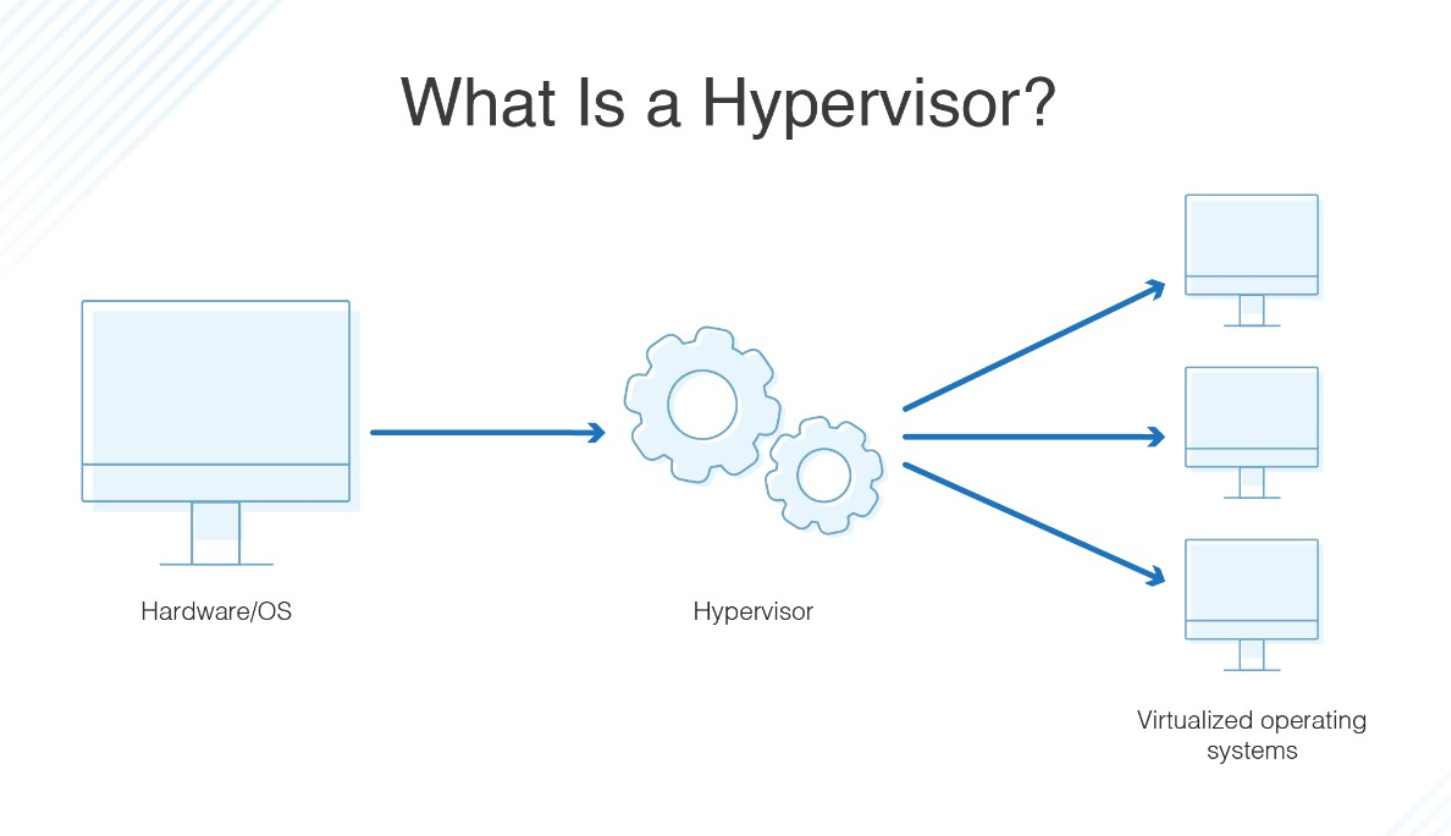What is a Hypervisor and Benefits of Hypervisors

A hypervisor, also known as a virtual machine monitor or VMM, is software that creates and runs virtual machines (VMs). A hypervisor allows one host computer to support multiple guest VMs by virtually sharing its resources, such as memory and processing.
Benefits of hypervisors
There are several benefits to using a hypervisor that hosts multiple virtual machines:
Speed: Hypervisors allow virtual machines to be created instantly, unlike bare-metal servers. This makes it easier to provision resources as needed for dynamic workloads.
Efficiency: Hypervisors that run several virtual machines on one physical machine’s resources also allow for more efficient utilization of one physical server. It is more cost- and energy-efficient to run several virtual machines on one physical machine than to run multiple underutilized physical machines for the same task.
Flexibility: Bare-metal hypervisors allow operating systems and their associated applications to run on a variety of hardware types because the hypervisor separates the OS from the underlying hardware, so the software no longer relies on specific hardware devices or drivers.
Portability: Hypervisors allow multiple operating systems to reside on the same physical server (host machine). Because the virtual machines that the hypervisor runs are independent from the physical machine, they are portable. IT teams can shift workloads and allocate networking, memory, storage and processing resources across multiple servers as needed, moving from machine to machine or platform to platform. When an application needs more processing power, the virtualization software allows it to seamlessly access additional machines.
Why use a hypervisor?
Hypervisors make it possible to use more of a system’s available resources and provide greater IT mobility since the guest VMs are independent of the host hardware. This means they can be easily moved between different servers. Because multiple virtual machines can run off of one physical server with a hypervisor, a hypervisor reduces:
Space
Energy
Maintenance requirements
Types of hypervisors
There are two main hypervisor types, referred to as “Type 1” (or “bare metal”) and “Type 2” (or “hosted”). A type 1 hypervisor acts like a lightweight operating system and runs directly on the host’s hardware, while a type 2 hypervisor runs as a software layer on an operating system, like other computer programs.
The most commonly deployed type of hypervisor is the type 1 or bare-metal hypervisor, where virtualization software is installed directly on the hardware where the operating system is normally installed. Because bare-metal hypervisors are isolated from the attack-prone operating system, they are extremely secure. In addition, they generally perform better and more efficiently than hosted hypervisors. For these reasons, most enterprise companies choose bare-metal hypervisors for data centre computing needs.
While bare-metal hypervisors run directly on the computing hardware, hosted hypervisors run on top of the operating system (OS) of the host machine. Although hosted hypervisors run within the OS, additional (and different) operating systems can be installed on top of the hypervisor. The downside of hosted hypervisors is that latency is higher than bare-metal hypervisors. This is because communication between the hardware and the hypervisor must pass through the extra layer of the OS. Hosted hypervisors are sometimes known as client hypervisors because they are most often used with end users and software testing, where higher latency is less of a concern.
Hardware acceleration technology can create and manage virtual resources faster by boosting processing speed for both bare-metal and hosted hypervisors. A type of hardware accelerator known as a virtual Dedicated Graphics Accelerator (vDGA) takes care of sending and refreshing high-end 3-D graphics. This frees up the main system for other tasks and greatly increases the display speed of images. For industries such as oil and gas exploration, where there is a need to quickly visualize complex data, this technology can be very useful.
Both types of hypervisors can run multiple virtual servers for multiple tenants on one physical machine. Public cloud service providers lease server space on the different virtual servers to different companies. One server might host several virtual servers that are all running workloads for different companies. This type of resource sharing can result in a “noisy neighbor” effect, when one of the tenants runs a large workload that interferes with the server performance for other tenants. It also poses more of a security risk than using a dedicated bare-metal server.
A bare-metal server that a single company has full control over will always provide higher performance than a virtual server that is sharing a physical server’s bandwidth, memory and processing power with other virtual servers. The hardware for bare-metal servers can also be optimized to increase performance, which is not the case with shared public servers. Businesses that need to comply with regulations that require physical separation of resources will need to use their own bare-metal servers that do not share resources with other tenants.
What is a cloud hypervisor?
As cloud computing becomes pervasive, the hypervisor has emerged as an invaluable tool for running virtual machines and driving innovation in a cloud environment. Since a hypervisor is a software layer that enables one host computer to simultaneously support multiple VMs, hypervisors are a key element of the technology that makes cloud computing possible. Hypervisors make cloud-based applications available to users across a virtual environment while still enabling IT to maintain control over a cloud environment’s infrastructure, applications and sensitive data.
Digital transformation and rising customer expectations are driving greater reliance on innovative applications. In response, many enterprises are migrating their virtual machines to the cloud. However, having to rewrite every existing application for the cloud can consume precious IT resources and lead to infrastructure silos. Fortunately, as an integral part of a virtualization platform, a hypervisor can help migrate applications to the cloud quickly. As a result, enterprises can reap the cloud’s many benefits, including reduced hardware expenditures, increased accessibility and greater scalability, for a faster return on investment.
How does a hypervisor work?
Hypervisors support the creation and management of virtual machines (VMs) by abstracting a computer’s software from its hardware. Hypervisors make virtualization possible by translating requests between the physical and virtual resources. Bare-metal hypervisors are sometimes embedded into the firmware at the same level as the motherboard basic input/output system (BIOS) to enable the operating system on a computer to access and use virtualization software.
Container vs hypervisor
Containers and hypervisors are both involved in making applications faster and more efficient, but they achieve this in different ways.
Hypervisors:
Allow an operating system to run independently from the underlying hardware through the use of virtual machines.
Share virtual computing, storage and memory resources.
Can run multiple operating systems on top of one server (bare-metal hypervisor) or installed on top of one standard operating system and isolated from it (hosted hypervisor).
Containers:
Allow applications to run independently of an operating system.
Can run on any operating system—all they need is a container engine to run.
Are extremely portable since in a container, an application has everything it needs to run.
Hypervisors and containers are used for different purposes. Hypervisors are used to create and run virtual machines (VMs), which each have their own complete operating systems, securely isolated from the others. In contrast to VMs, containers package up just an app and its related services. This makes them more lightweight and portable than VMs, so they are often used for fast and flexible application development and movement.
